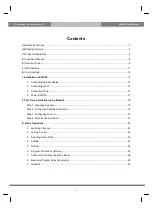
QCX assembly Rev 1.08
111
R36 is a logarithmic potentiometer used as the gain control. With the wiper fully clockwise the
receiver is at full volume. As the potentiometer is turned anticlockwise it forms a potential divider
which attenuates the audio signal from the CW filter output.
There is also a TX mute switch formed by Q7, another BS170 MOSFET. This was a late addition
to the design: despite all attempts, I could not remove the nasty click on receive/transmit
switching. The mute switch helps to attenuate it. The switch is operated by the microcontroller
Receive/Transmit switch output. When the BS170 switch is on, it has a low resistance to ground
which greatly attenuates the audio signal.
To reduce the audio “thump” when the transceiver is switched from transmit back into receive, the
mute switch needs to remain switched on for a short while after the receiver is switched back on. A
small wait while the thump subsides. This delay is achieved by the R-C network formed by R60
and C52. This would also introduce a delayed switch-on of the mute switch, which would allow the
thump when switching to transmit to be heard. To prevent this, diode D5 was added, which
bypasses the resistor R60 at the receive-to-transmit switchover. It ensures that at the receive-to-
transmit event, the mute switch is enabled instantly; but on the transmit-to-receive switchover
there is a short delay.
IC10B is a simple amplifier configured for 41dB of gain. The ½-V midrail bias is created by R39,
R40 and C24. Using the 5V power line as “midrail” was found to add too much noise. Finally,
IC10A is a simple unity-gain buffer. Although it is just an op-amp it is found to be perfectly
adequate for driving standard earphones.
Summary of Contents for QCX 5W CW
Page 9: ...QCX assembly Rev 1 08 9...
Page 10: ...QCX assembly Rev 1 08 10...
Page 12: ...QCX assembly Rev 1 08 12...
Page 50: ...QCX assembly Rev 1 08 50...
Page 105: ...QCX assembly Rev 1 08 105...















































